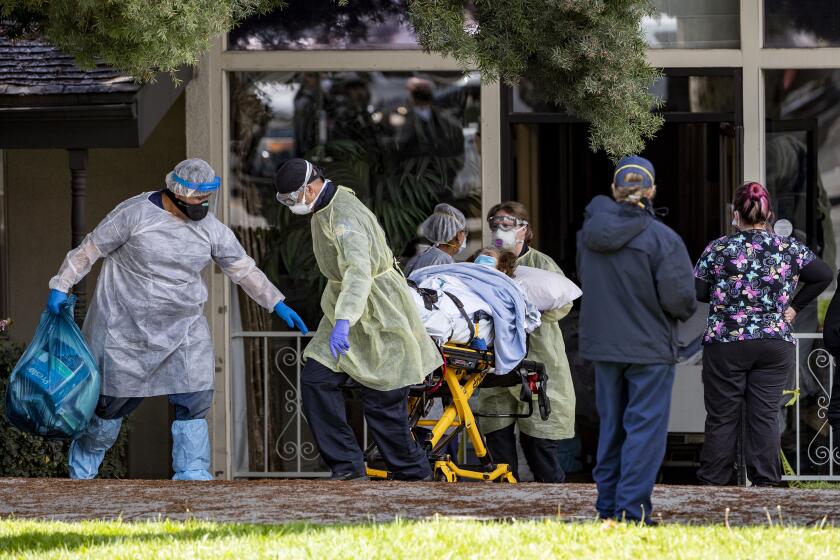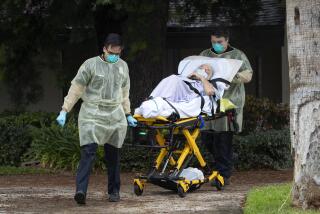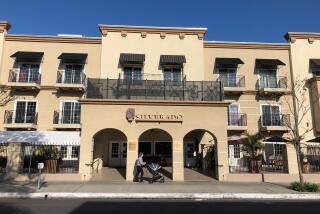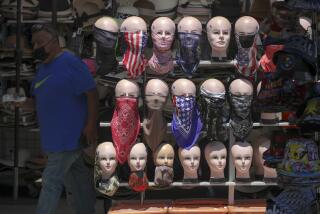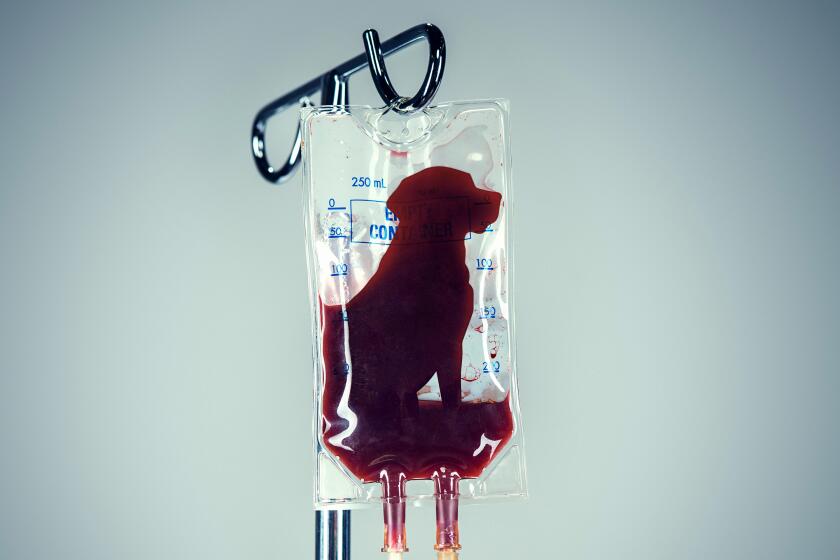Coronavirus is attacking nursing homes with poor infection track records in L.A. County

- Share via
The vast majority of skilled nursing facilities battling outbreaks of the novel coronavirus in Los Angeles County have been cited in recent years for violating federal safety rules on preventing infections, according to a Los Angeles Times analysis of nursing home data.
The newspaper‘s review found that 89% of facilities with the coronavirus had previous infection control violations that ranged from mishandling patients with highly contagious bacterial infections to not properly cleaning ventilators and other equipment.
The data raised new questions about how prepared nursing homes and regulators were to deal with the pandemic.
Long-term-care facilities have become the epicenter of the coronavirus throughout the nation. Their concentration of elderly people with underlying health problems makes them exceptionally vulnerable to outbreaks.
These are some of the unusual new scenes across the Southland during the coronavirus outbreak.
In California, the virus had sickened more than 1,200 residents and staff in nursing homes as of Friday. As of Monday afternoon, 29% of the 320 people in Los Angeles County who had died from COVID-19, the disease caused by the virus, were residents of nursing homes, county officials said.
Even the most highly rated homes can fall prey to the virus, which can be spread by asymptomatic carriers who appear to be healthy. The Life Care Center in Kirkland, Wash., had a five-star rating — the highest possible — from Medicare yet wound up with two-thirds of its residents and 47 workers falling ill, and more than three dozen people dead.
Many experts have warned for months about the high death toll they expected at nursing homes, particularly those with an established track record of infection control deficiencies.
“I am not surprised,” said Charlene Harrington, professor emeritus at UC San Francisco’s School of Nursing, when told of The Times’ findings. The problem stems from weak enforcement by regulators and chronic understaffing at homes, Harrington said.
“The understaffed homes don’t do handwashing and don’t have time for infection control,” she said. “They also don’t have enough RNs to oversee the infection control.”
In thousands of care facilities, where the coronavirus’ deadly toll has been acutely felt, staffers are growing scared, sick and overwhelmed as cases and deaths mount.
Although infection control deficiencies are the most common violations for nursing homes, facilities that have struggled with the guidelines in the recent past dominate the list of those with outbreaks in Los Angeles County.
The Times examined the safety records of 66 skilled nursing facilities that the county listed on Friday as having reported at least one COVID-19 infection among staff or residents. The analysis found that 59 were cited for infection control problems since 2017.
There’s no reason to believe that the findings are unique to Los Angeles County, which is one of the few jurisdictions in the country that has publicly named homes with positive COVID-19 cases, making such an analysis possible.
California’s public health agency has not released names of homes with outbreaks statewide, but the Los Angeles County Department of Public Health lists local facilities with at least one positive test and identifies which of those have at least three cases. In addition to skilled nursing homes, the list includes assisted living facilities, jails, prisons and other facilities that were not included in The Times’ analysis.
Harrington said California’s public health officials made the problem worse on March 30 when they waived staffing requirements for skilled nursing facilities during the coronavirus emergency and curtailed inspections and monitoring.
Michael Connors, a spokesman for California Advocates for Nursing Home Reform, said regulators should have known that deadly outbreaks were “especially likely in nursing homes that have never paid attention to safe infection control practices.”
More than 100 local nursing homes and communal living facilities have seen coronavirus cases. Pulling out residents is advisable, county leader says.
“The state knows which nursing homes have histories of poor infection control practices, neglect and understaffing,” he said. “Why hasn’t it assigned an inspector to conduct on-site monitoring at each of these facilities on a daily basis?”
A spokesperson for the California Department of Public Health acknowledged that routine inspections of nursing homes were on hold and that surveyors were being advised to conduct complaint investigations “through virtual, audio or electronic methods.”
However, the spokesperson said, the state “has been and will continue to send strike teams of nurses, in partnership with the counties, to facilities with COVID-19 outbreaks. CDPH also continues to do on-site inspections for any complaint of ‘immediate jeopardy’ of harm to residents.”
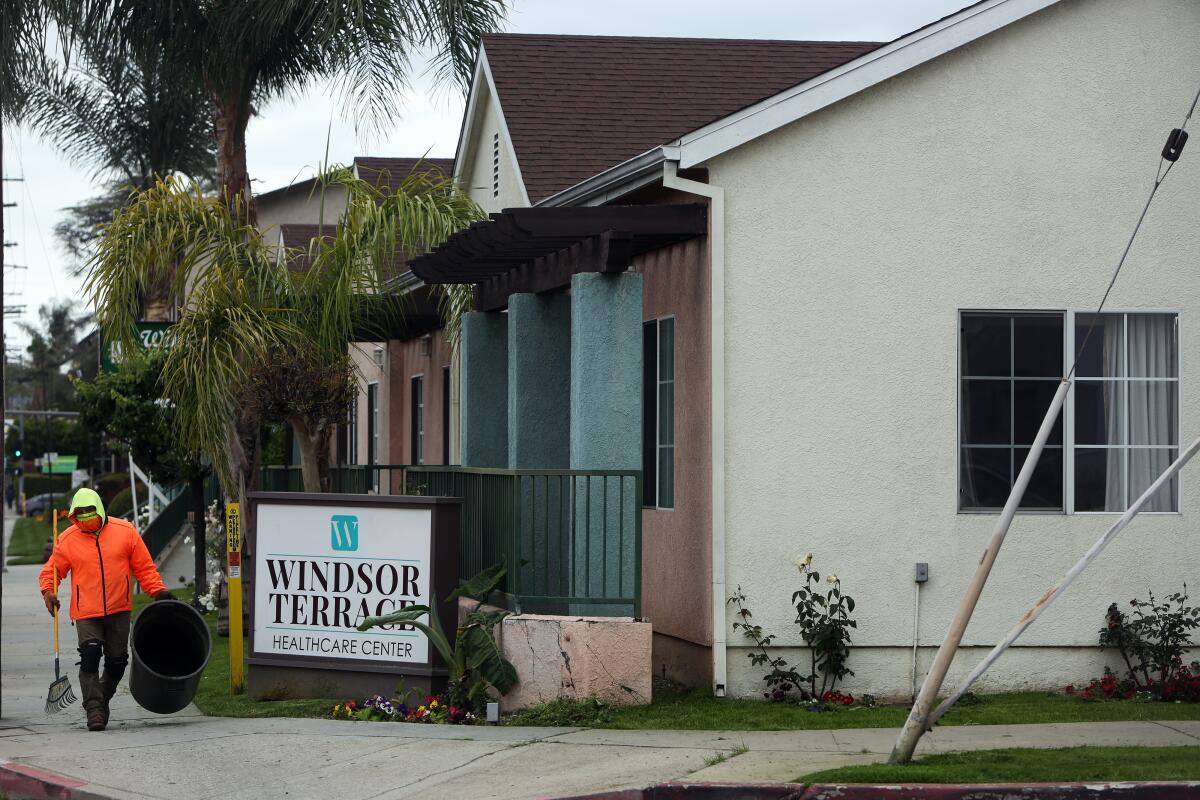
Windsor Terrace Healthcare Center in Van Nuys has had four infection control violations since 2017, records show.
Last year, regulators found that nurse aides failed to wash their hands or put on protective gowns and gloves before entering the room of a resident who had been placed in isolation during treatment for the contagious C. diff bacteria, which can cause life-threatening diarrhea and inflammation of the colon. That and other violations put 122 residents at risk of infection, according to federal deficiency records.
The year before, nurses at the home sent a patient who was isolated for C. diff to an outside lab for a CT scan without alerting the staff at the lab that the patient was under “contact precautions.”
Reached by phone Monday, Victor Carpio, the home’s director of nursing services, said Windsor Terrace had “since resolved those things.”
Carpio said he had been working around the clock and was in daily contact with the county’s public health department to meet infection control requirements.
“I just want to thank the [staff] for actually washing their hands and following [protective equipment] protocol,” Carpio said. He declined to say how many residents and staff had tested positive for the coronavirus.
Another nursing home on the L.A. County list that has had four infection control deficiencies since 2017, according to the records, is Beachwood Post-Acute & Rehab in Santa Monica.
Beachwood routinely exceeds the statewide average for the number of complaints and deficiencies, according to the California Department of Public Health, and is rated with only one star on Medicare’s scale.
In November 2019, during an investigation following a complaint, a regulator noticed that a staffer did not clean a chair and portable ventilator used to help a patient bathe. The chair and ventilator — devices in high demand now because they help people in respiratory distress — were left outside in the hallway. Both items should have been cleaned to “prevent cross-contamination between residents,” according to a statement of deficiencies from the federal Centers for Medicare & Medicaid Services.
In July and September, regulators found Beachwood staffers were leaving drink containers in carts with clean linen: a cup of coffee, bottled water, a can of Coke, a box of milk. The infection control violations put “39 of 197 residents at risk of cross-contamination,” regulators noted.
”It’s very common to have infection control deficiencies during regulatory visits,” said Anton Novitsky, the administrator at Beachwood, who declined to say how many cases of COVID-19 had been discovered at the home. “With the number of nursing homes that have COVID cases, I don’t think there’s any correlation you can draw.”
Relatives of some former Beachwood residents are less forgiving.
Eileen Kelley-Wheat said her sister Kathy was placed at Beachwood following a stroke. Kathy suffered recurring fevers and infections while at the home, Kelley-Wheat said. “Every week she would have an infection.”
Near the end of her life, Kathy was transferred to the hospital. When her treatment finished, “I fought tooth and nail to keep her at the hospital,” Kelley-Wheat said, so she wouldn’t be sent back to Beachwood. “I could not let Kathy pass away at a dark, gloomy, uncaring facility.”
Ali Iravani’s father, who was essentially paralyzed from the neck down by multiple sclerosis, ended up at Beachwood after a bout with pneumonia. The home was just down the street from UCLA Medical Center, where his dad had been treated.
“I was thinking to myself, it can’t be that bad, it’s in Santa Monica,” Iravani said, but, “it was like a nightmare from day one.”
Iravani said his father was at Beachwood for 60 days, but “it felt like 60 years. Every day was like straight anxiety,” he said.
“If I knew my family member was in a place like Beachwood during this pandemic — I remember how I felt with no pandemic — I don’t even think I could sleep,” Iravani said.
More to Read
Sign up for Essential California
The most important California stories and recommendations in your inbox every morning.
You may occasionally receive promotional content from the Los Angeles Times.

